#us american film maker
Explore tagged Tumblr posts
Text

Mishima: a Life in Four Chapters
#mishima#mishima: a life in four chapters#paul schrader#masato aizawa#japanese actor#us american film maker#international cinema#1980s#saint sebastian#guido reni#black and white#book illustration#illustration#yukio mishima#japanese writer#homoerotism
33 notes
·
View notes
Text
DUCK! THE CARBINE HIGH MASSACRE - EVERYTHING YOU NEED TO KNOW!
Hello!!!! i’m very autistic and I wanted to put my effort into something I could share with you all, so without any more unnecessary ranting here’s all you need to know about duck! the carbine high massacre. please comment anything I should add or any mistakes I may make, beware this is my first post like this so im a newby go easy on a gal!
Full film:
https://youtu.be/UScvX4bjExg?si=Cohq29YGoYCsOtBY
Trailer:
https://youtu.be/zNtUviDpyQg?si=23nQgFQo75OQ-RC_
Film soundtrack:
https://youtu.be/2ky9FrEj8Fk?si=DqRVcTdFQEtJ6owC
Website archived:
https://web.archive.org/web/20040815013848/http://www.duck2k.com/docs/carbine_comm.html
Other interviews unrelated to specifically this film:
https://youtu.be/gEbZVXdsX-U?si=cG5bTGb41ee-1fFh
https://youtu.be/WUjqIoDidr4?si=sDMMUzzKhIWImuL5
https://youtu.be/W04lj1BdK0o?si=DHRIixDEpn39KBne
Filming:
Duck! the Carbine High Massacre was a spoof about Columbine that was made soon after the massacre, infact only 6 months after. It was created by Joey Smack (Joseph Miller) and William Hellfire (William Apriceno) two (at the time) collage aged film makers. A lot of viewers received it as this as distasteful and terrible, but others find this to be one of the greatest movies of all time. Smack and Hellfire mainly made a living on creating fetish content for their small but loyal cult following, but unlike most of Smack and Hellfires other films this one was based on true events and NOT made for fetish content. (it only had a few titties here and there ;-D) A lot of people who had starred the movie had received a lot of back lash including piles of death threats.
Duck, along with most other Factory 2000 films was edited in Adobe premier and shot on VHS cameras including a broadcast Super VHS camcorder, a handheld RCA, and another unidentified camcorder.
The films first dvd release was in 2004, along with minor color corrections.
The whole budget was about 3,000$ along with inexperienced actors, most of them being Hellfire and Smacks friends taking some time off work.
On Columbines anniversary they had a showing of the film at CBGB’s where an interview with Court Tv was held and they had stated some of the reasons behind making the movie, what they would say to the parents at Columbine, and the reasoning behind making the movie.
It was here where they explained they were *not* making fun of the victims but instead the media in America’s portrayal of all the victims and the shooters on the news.
Interview:
https://youtu.be/QjPlPsGUuKI?si=gel6kBCbpzmUmiDE
The producers had gotten arrested for creating this film, not because of the crude nature but because they had brought fire arms onto school property .
Court Tv producers getting arrested:
https://youtu.be/i7LiNTkksJs?si=C8IbynDgwj9oP9YE
The film racked up $6,034 in the box office and the film was said to have helped pay Hellfires legal fees.
Experiences on set:
William hellfire stated that he did remember filming and creating most of duck because he was so drugged up on pain killers he was using to treat his cancer pains. He had no remorse or regret for making the film
Chris Perez hopped on reddit to describe his experience “Fun and loose. Everyone was really laid back and chill and we had a good time with the filming. There was a script, but we also improved a lot of stuff. Sometimes, Bill, Joe, and Todd would just give us a general idea of what they wanted us to do and say and we'd work off that.” He along with many others would receive blowback from the incident.
Misty Mundae said that the film was a "crappy little movie" which "has permanently staked its place in underground cult cinema"
Cast:
Derick- Joey Smack (Joseph Miller)
Derwin- William Hellfire (William Apriceno)
Retard- Henry Krinkle
Bible Girl- Misty Mundae (Erin Brown)
Play Girl- Lilly Tiger
Car Kid- Chris Perez
Spam Jock- Michael Ovum
Benchpress- Ryan Trimmer
Afro-American- Kendall "Shorty" Ward
Song Girl- Mazur
Goth Boy- Mike Roser
Goth Girl- Liz Bathory
No Info Boy- Michael Lema
The Principal- Larry Wellman
The Janitor- Rodney Sleurtols
Policeman- Karl Pitt
Plot:
With a running of 101 minutes Duck! the Carbine High Masscre was about spoof about the events that took place at Columbine on April 20th, 1999. The movie took place at Carbine high school where two bullied, neo-nazi, trenchcoat wearing high-school students, Derick and Derwin fail at a double suicide attempt. While walking home Derwin gets attacked by jocks and misses school the next day. After school it is then the two high schoolers plan a massacre against their school. The pair then bought several guns from a black market dealer. The next day the two boys bid farewell to their parents for the last time and head to school with the guns in arm. Once they get to school they head to the cafeteria trying to get the student’s attention, when yelling failed Derwin got onto a chair and yelled “What’s for lunch?” before the two began shooting. The two kill several people in gruesome manners before heading down to the basement and sharing a last cigarette before shooting each other.
Other films:
William Hellfire and Joey Smack typically made fetish films and soft-core porno flicks, some notable ones include (but are not limited tooooo!) Erotic Survivor, Silk Stocking Strangler, Vampire Strangler, TITanic 2000, and so many other underground gems. I, infamousbondagemurder sincerely urge you to watch these movies, buy the dvds, and support the living William Hellfire.
Here’s a link to watch more movies by William (unfortunately not ALL his movies are on this keep in mind. i also did not create this link so credits to the creator, which i’m not sure who the creator is)
https://docs.google.com/document/d/1-2iH0WjcolYtbat61F2zLs8SSw5dbMy15mnCnuq4suE/edit
What most people don’t know is Joey Smack starred in the semi-popular film Where the Dead go to Die, where he voice acted as the characters Ralph Stanley, Tommy’s father, and The legless war veteran. He dropped iconic lines in this movie such as: “You fuckin’ dog! What the fuck are you some sort of faggot cannibal! Aggghhh! Your eatin’ my dick!”
Dvd:
Hello! so I am basing this off of the DVD that I personally own, these details may differ from DVD to DVD so if you own a different sort of DVD, please comment anything extra that you have on yours.
Dvd includes:
* Deleted scenes
* Behind COURT TV- cbgb’s screening
* PRODUCER/DIRECTOR interviews
* TODAY is the DAY LIVE in Hoboken NJ
* KING GHIDORAH! LIVE in Hoboken NJ
* Original trailers
* Shooting gallery
* Film soundtrack
* And of course, this wonderful shitty movie :-)
Rest in peace Joey Smack:
On Saturday June 29th, 2019 Joseph Robert Miller, better known by many fans as ‘Joey Smack’ passed away. The circumstances are unknown and a mystery to all fans. There are rumors of suicide but there are no confirmations. I advice you to read his obituary and donate to catholic charities, diocese of paterson, the charity which paid his brother joshua's medical bills after his passing in 1998.
Joseph was loved by many and passed at the age of 41. Fans, family and friends all mourn him to this day. He was described by friends as a kind hearted true and utter weirdo, who had lived in his own world. he didn’t talk to many people but if you had been let into his select group, he would go out of his way to make friends laugh and smile with his warped sense of humor.
His memorial services were held Tuesday, July 2nd, 2019 from 5:00 to 8:00 p.m. at Browning-Forshay funeral home on Lafayette Ave in Hawthorne.
Rest in peace Joey Smack, a truely great man who loved what he did and put so much love into all of his creations. Well wishes to his surviving family and friends:
Joey Smacks obituary:
https://emeto.neocities.org/joeysmack
CREDS:
Mainly wiki like a chud
Actors themselfs
The dvd
I’m dumb


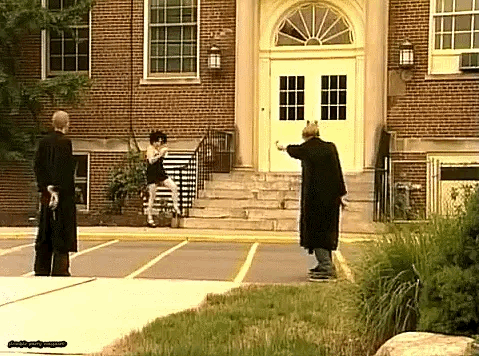
#duck the carbine high massacre#duck! the carbine high massacre#joey smack#tccblr#william hellfire#tcctwt#tcc tumblr#tc community
683 notes
·
View notes
Text
Red Hot Chili Peppers - Give It Away 1991
"Give It Away" is a song by American rockband Red Hot Chili Peppers, released as the lead single from the group's fifth studio album, Blood Sugar Sex Magik (1991). The song went on to achieve international fame, reaching number one on the Billboard Modern Rock Tracks in late 1991, giving the band their first ever number one single. It also became the band's first top ten hit in the UK, where it peaked at number nine on the UK Singles Chart; this did not occur until February 1994, nearly two and a half years after it was first released in the US.
The accompanying music video, which was directed by French film-maker Stéphane Sednaoui, was put into heavy rotation on MTV and added to the band's success. The video was nominated for three awards at the 1992 MTV Video Music Awards: Best Alternative Video, Breakthrough Video, and Best Art Direction; it won the latter two. Since its release, "Give It Away" has gone on to receive numerous accolades, including a Grammy Award for the Best Hard Rock Performance With Vocals in 1992.
"Give It Away" received a total of 57,3% yes votes. Previous RHCP polls: #92 "Otherside".
youtube
486 notes
·
View notes
Text
East Blue Crew modern au!

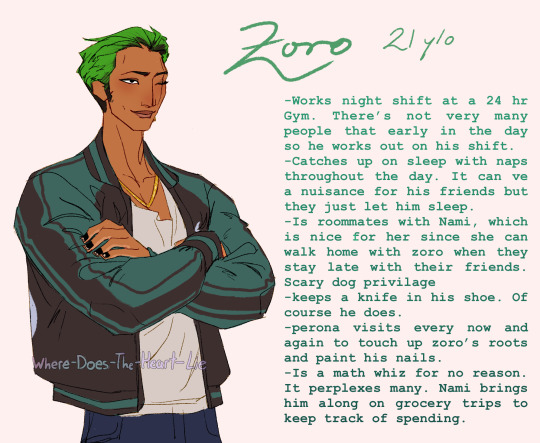
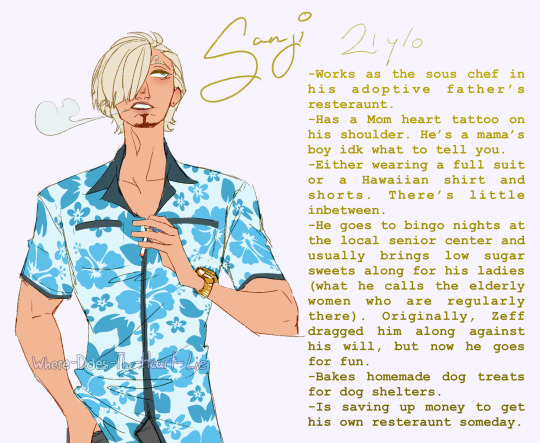
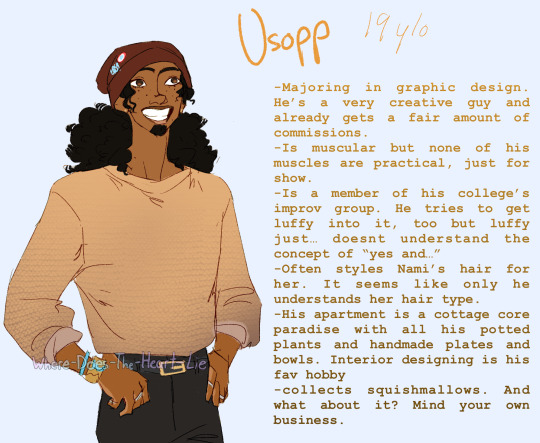
Ive been working on this on and off for a while now.
There’s a lot here so [rings dinner bell] come get y’all’s meal
ASL Modern Au Post
Grand Line Crew Modern Au
Friends We Made Along The way post
Friends We Made Along The Way Part 2 post
Additional Headcanons:
Nami needs her own episode on extreme couponers. Sis has an entire binder dedicated to it.
Zoro cannot for the life of him beat Luffy in an arm wrestling match. No matter how much he lifts or trains, he always loses.
Zoro is actually pretty good at grilling. Sanji was pleasantly surprised when the burger that was presented to him wasnt a pile of ash/ so raw its still walking around. One day the two will have a grill off.
Usopp and Luffy love playing yugioh with eachother. Neither of them actually know the rules of the game, they just make it up as they go.
Nami used to collect american girl dolls and she keeps them in a closet in her apartment. One day when usopp luffy and chopper were snooping around, they found the accursed closet and were scared shitless.
Usopp has an ant farm and luffy thinks its the coolest shit.
In this modern au, sanji takes the place of that one guy on tiktok who makes duets with cooking videos, and films until they put the entire block of cream cheese in the crock pot.
Sanji is also this guy
Even though nami has scary dog privilege when walking with zoro, its not just beneficial to her. In fact nami has outlawed zoro from going on walks in general alone, as he would get lost and need nami to walk to him to direct him home. Nami has scary dog privilege and zoro has sense of direction privilege when they walk together
Sanji and Nami rewatch Pretty Little Liars/ Gossip Girl/ Glee/ and other CW drama shows together.
Nami and Usopp always be shit talking someone/something. They are hateful bitches.
How luffy meets each of them:
Zoro- they met each other because the 24 hr gym Zoro works in is right down the street from Luffy’s apartment and one day Luffy was walking by at around 3 am and noticed Zoro in there. Luffy asks him if he wants to join him fucking around at 3 am on the streets of this city area they live in and Zoro accepts after a little convincing from Luffy. When they get outside Zoro’s like
“where’s the rest?”
“Of what?”
“Of your friends”
“Its just you rn”
“… :| i mean, i had assumed you werent alone”
“Nope!”
“HA OkAy”
Nami- they took the same economics course together. They were paired up in a project and hit it off after that and often had study sessions together. Their defining friendship maker though, was they teamed up to steal the answer key to the test they were both definitely going to fail because the class was bullshit.
Usopp- they had taken a graphic design course together. Luffy had no idea what he was doing the entire time and Usopp was very happy that he could impart his wisdom uponst this newcomer to the arts. Although luffy did already have some… incredible(?) art skills of his own already. It was instant chemistry for them honestly, their synergy just clicked and before they knew it, they were besties.
Sanji- works in the restaurant thats underneath the ASL brothers’ apartment complex. Their fist encounter with the restaurant was not of them going in to eat there, though. The trio were throwing around the ol’ pig skin in the street in front of their complex when luffy failed to catch the ball, and accidentally ricocheted it into the front window of the Baratie, through the eating area, over the counter, and into Mr. Zeff’s face. Zeff stormed out of the eatery and asked which of them destroyed his glass and hit him in the head

And luffy looks over and notices his brothers selling him out and is like “HEY!!! D:” So luffy was stationed as the place’s chore boy and met sanji while working there. 2 years later the debt was repayed, sanji and luffy are friends, and the Baratie is ASL’s fav eating place due to the great food, delightfully violent vibes, and great company.
thats all for now, hope you enjoyed!
#my art#one piece#one piece fan art#monkey d. luffy#headcanons#east blue crew#roronoa zoro#sanji#vinsmoke sanji#usopp#nami#one piece modern au#straw hat crew
3K notes
·
View notes
Text










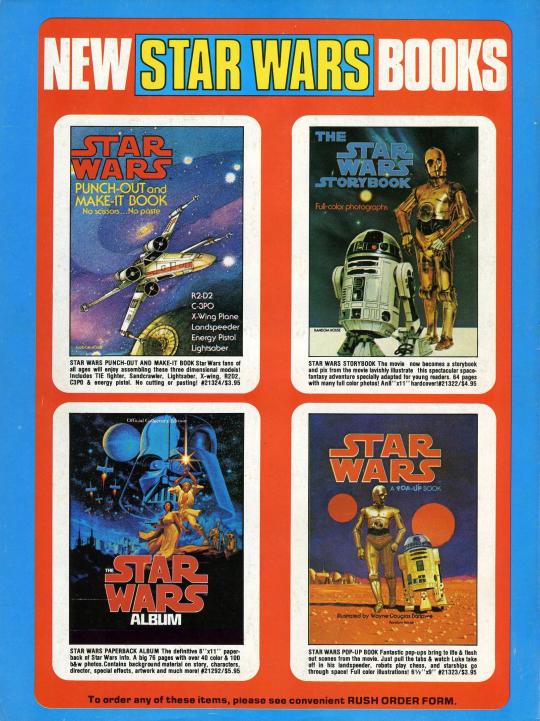

A host of 'Star Wars' advertisements from magazines published in the late 70s and early 80s. 'Star Wars' toys, games and tie-ins have become the most profitable franchise merchandise ever sold. There was a time when 'Star Wars' merch was inescapable. It was everywhere. Ubiqituous. Of course, no one thought that would happen. After 'American Graffiti' became a hit (it became one of the most profitable movies ever made), Lucas was afforded greater leverage over the pre-production of 'Star Wars'. Most of the profits he got from 'American Graffiti' went into the pre-production of 'Star Wars'. He created Industrial Light and Magic, hired artists to help create the aesthetics of the original film, and eventually waved his directing salary in favor of receiving greater control over the production of 'Star Wars' (plus any sequels) and over all the ancillary rights of the film. One of those ancillary rights was merchandise. George Lucas sought out toy makers like Mattel and Mago to produce toys in advance of the release of 'Star Wars', only to have company after company turn him down. Lucas eventually cut a deal with Kenner (then a division of cereal maker General Foods) for a flat fee of $100,000 per year, indefinitely. "The designers knew they wanted to make toys of the spaceships, but the usual 8- or 12-inch dolls would make that impossible, so they instead created 3 ¾-inch plastic action figures that would become the new industry standard."
The crazy thing is, Kenner didn't expect the popularity of 'Star Wars' and that means they didn't anticipate the demand for 'Star Wars' toys. They ended up selling a kind of IOU to customers, what they called an ‘Early Bird Certificate Package’ which could be redeemed later for four 'Star Wars' action figures. Given that popularity, between 1977 and 1978, Kenner sold $100 million worth of 'Star Wars' toys. As of me writing this very truncated history of 'Star Wars' toys (for no real reason), the merchandise makes around $3 billion a year. The one thing I do remember as a wee lad was mailing out for an early version of the Boba Fett action figure before the release of 'The Empire Strikes Back' in 1980. I was one of the fortunate kids who actually got a figure in the mail while other kids received an apology letter promising them a figure ASAP (one of my friends was a recipient of one of these cards). That Boba Fett figure was the only surviving toy from my childhood and I had it up until 2014 when it disappeared one day never to be seen again. Where did it go? I have no idea. The world's an impermanent place and all things are transitory (I should note, before I go, our culture's entire economy being predicated on producing an insatiable appetite for consumerism is collectively killing us. Just saying.)
#Star wars#star wars toys#star wars merch#george lucas#kenner toys#boba fett#advertising#toy advertisements
76 notes
·
View notes
Text
So I shared, the Spanish-language horror visual references in this week’s Peaceful Property episode (which are great ghost story films for comparison in thematic elements, as well). The death this week, though, is yet another ghost story reference, this time in an English-language series with lots of commentary on class and the racial and gender politics of domestic work, The Haunting of Bly Manor.
🚨spoilers for both series from here on🚨


In Bly Manor, Hannah Grose, the estate’s maid is revealed late in the series to be a ghost, who had fallen into a well on the grounds. Although the series is based off Henry James’s Turn of the Screw and its celebrated film adaptation The Innocents from the 1960s and its celebrated 2000s remake The Others* with Nicole Kidman (in which the twist from the previous is that the governess main character is revealed to be dead), Hannah Grose’s death is a new addition in the Netflix series. It compounds the complex themes about class and domestic servitude in the original British story and adds issues of race to the proceedings.
Peaceful Property uses Baanchuen’s story for similar purposes. Migrant domestic work is an important issue in Southeast Asia. The International Labor Organization put out a report last year stating, “29 per cent of surveyed migrant domestic workers in Malaysia were in conditions meeting the ILO’s statistical definition of forced labour; as were 7 per cent of surveyed workers in Singapore and 4 per cent in Thailand. Indicators of involuntariness include not being able to quit your job, having to stay in the job longer than agreed, and being made to work without overtime pay, among others.” Shackles, like those on Baanchuen’s ghost, are an easily recognizable symbol of enslavement, indicating the extent of Aunt Phom’s cruelty.
But even under legal circumstances, domestic workers are one of the least protected group of laborers in Thailand and abroad. Taiwanese-American labor organizer, MacArthur “genius” grant recipient, and mentor/friend to BLM cofounder Alicia Garza, Ai-Jen Poo has a fantastic interview on On Being, in which she discusses the racialized, gendered, international, and cross-class dynamics that define domestic care work, which impacts the strategies to organizing for workers rights in the field.
“The average annual income for a home care worker [presumably in the US at the time of recording in 2020] is $15,000 per year. And I can’t think of any community that I’ve ever lived in where you can survive on $15,000 a year. It’s really quite extraordinary. And they’re there and see employers come home with a pair of shoes that are maybe more than they make in a week, and yet, their job is to care and support and love, and they do so. You can’t actually do your job as a caregiver if you dehumanize the person that is in your charge. And I think that that is so much of what’s needed in this moment. All of us need to understand that we have a profound set of challenges and inequities that we have to deal with and transform, but we have to do it with a boundless sense of compassion and humanity.”
I’d encourage some of my fellow watchers of Peaceful Property to heed Poo’s perspective on disrupting class distinctions and what the advocacy for equitable practices has looked like in her work. I’m a caseworker myself and have worked alongside people who had less privilege than me for caring wealthy people who never the less didn’t always recognize the value of those whose work they depended on and didn’t have the labor laws that might provide that guidance. There are a few pieces of work that explore this meaningfully (better than The Help, although Viola Davis and Octavia Spencer absolutely carved out depths in their characters stories that weren’t there on the page). Glad to see Peaceful Property making its attempt to explore these depths. It actually made me reflect on how many of the jobs after the first episode really focused on gendered aspects of labor—a wig-maker, assistants, food-making…
And for my Homepeach truthers out there, that gender conversation is not just about labor. Bly Manor is also notable for its queer romance storyline with a wealthier character running from her internalized homophobia/guilt after a car accident…
*Incidentally, The Others is also heavily influenced by the same Spanish film, The Spirit of the Beehive, as both referenced Spanish-language horror films in these weeks episode.
#peaceful property#peaceful property the series#on sale the series#peachhome#thai bl#gmmtv#the haunting of bly manor#bly manor#meta
30 notes
·
View notes
Text
Harum Scarum Review

The second Gene Nelson and Sam Katzman picture starring Elvis Presley. Inspired by Rudolph Valentino's The Sheik and filmed on the original Cecile B. DeMille's set of The King of Kings, Elvis had hope of finally getting a movie that allowed him to be more of an action hero. Given that Peter O'Toole's 1962 film, Lawrence of Arabia was a massive success for Columbia Pictures, MGM likely wanted to capitalize on that success by using a guaranteed money maker in Elvis.
Unfortunately, the hype Elvis had regarding the possibility of being a Rudolph Valentino figure was quickly squashed. He received the script and realized that his character wouldn't live up to the expectations he originally had. It's a pretty known story that even the Colonel thought the script was so weird, he thought it should include a talking camel. This of course is in reference to the Bing Crosby and Bob Hope movie, Road to Morocco. Ironically enough, the reference I make to Zanzibar in my announcement post was another movie that the duo made. With Kissin Cousins being described as the begin of Elvis' decline, this movie is typically described as being Elvis' rock bottom. Is it really as bad as people say, or is it over hated due to outdated elements? Let's find out.

"Harem Holiday" while it sounds great, is very confusing in the context of this movie. Why is this movie called Harum Scarum when it's called Harem Holiday elsewhere and even has a song with that name? I get that it's a term meaning someone acting reckless and without care, but it doesn't relate to the movie at all. Both titles completely gloss over the very important detail of how Johnny ended up in the position he will end up in.
We immediately open to a movie within a movie as Johnny Tyrone stars in an Arabian film where he saves a woman by killing a jaguar with his bare hands. He even sings to her "My Desert Serenade" while he has the weirdest sideburns I have ever seen. And then the movie just ends to a roaring applause in front of what's an unusually white crowd.

Apparently this is being screened in front of Arabian dignitaries as a diplomacy mission by the US State Department. Why is this specific actor's movie being chosen for this mission when just by what we're shown, would be the equivalent of going into the Soviet Union and screen a movie of Elvis fighting a polar bear in Siberia? Only 2 minutes in and I already have a lot of questions on why this is the set up. He sings "Go East Young Man" and again why is this the song that you're choosing to perform in front of dignitaries you're supposed to schmooze? Again it'd be the equivalent of going into the Soviet Union and singing a song about drinking vodka with Josef Stalin. It's just so stereotypical that if this was a real diplomatic mission, it would be an absolute disaster. Dignitaries that you're trying to establish a relationship with, wouldn't see this as honoring their culture. If anything, what this movie should be about, is Johnny being kidnapped because they found his performance insulting.
Johnny Tyrone in this picture above summarizes Elvis' acting throughout the entire movie. Sir, you are meeting actual royalty and this is how you act? I can understand wanting to make a good impression but for goodness sake crack a smile. Or at the very least show humility by bowing before the prince. For someone who's supposed to be an actor/stuntman that was given a golden opportunity to act as a diplomat of American culture on this mission, Johnny looks like if it wasn't for Aishah, he literally couldn't care less to be there. Even when the prince invites Johnny to the king's palace (making him the first American to ever do so) Johnny looks bored out of his skull.

After traveling with the prince to Lunarkand, Johnny stops at a camp. Johnny goes to flirt with Aishah and we get a Red West appearance as on of the attackers. I know Star Trek didn't come out yet, but what is up with these costumes? These men look like an alien race trying to disguise themselves as human. Also this is the worst depiction of drugging someone I have ever seen. It's obvious that Aishah drugged his drink, but what drug could possibly work that fast? Whatever plot they want to commit would be executed a lot faster if they simply used a little too much of the Brand X drug if it's truly that effective. Drinking something is the slowest method you could possibly use to drug someone. It doesn't go directly to the brain like inhaling a substance.
The prince is obviously behind this and any twist that comes from it, is gone. My reason why it's so obvious: the prince would be completely incompetent if he traveled without any type of security for himself. So the fact that these men were able to enter his camp with absolutely no resistance indicates that this was planned to happen. If this was truly just a plot by Aishah, he would've been a victim as well to get the King's attention or attempt to implicate Johnny for the crime so Lunarkand would go to war agains the US. But that didn't happen. The prince is conveniently resting in his tent while Johnny is kidnapped.

I have never laughed so hard at an Elvis movie as I did when Johnny starts singing "Mirage". You have Johnny who was just kidnapped waking up in a strange place and what does he do? He literally starts singing to the slave women thinking this is just a dream. How in the world are we supposed to take anything that happens in this movie seriously? Johnny is being held captive in a Middle Eastern country and nobody will even know about it until after a week when Johnny doesn't return from his vacation. But no we need to have a gag about how Johnny's horny for slave women.
Even when he's facing Sinan, the leader of assassins who wants him to kill the King of Lunarkand, he still doesn't seem to care. All he does is make a snarky remark about how stupid it is to believe he can actually kill a jaguar with his barehands. Even if it was actually true, that just makes him all the more boring. Why should I care about Johnny Tyrone, if he's shown to be physically invincible and doesn't even seem all that scared about the amount of danger he's in? That isn't relatable. It's especially worse when you get the racist stereotype that poor Arabians are thieves in the form of Zacha offering to help Johnny escape for 10,000 American dollars. He explains how this country is so isolated that there's airport. How would Zacha even know what an airport was if Lunarkand's been isolated for 2000 years? And how does he speak fluent English if Johnny's the first American to even be on palace grounds? I just don't get how this world is set up.

Johnny escapes and runs into Princess Shalimar who for literally no reason says she's a slave girl. This would absolutely never happen and if anything makes me even more suspicious of the prince. Shalimar is a princess so she should have guards everywhere. Johnny would've been immediately captured just by being near her. Shalimar wasn't there during Johnny's movie screening so she has no reason to believe that he isn't going to be a danger to her. Johnny being hot isn't enough of a reason to trust him.
It also makes Johnny's plight even more frustrating to watch. For someone who's supposed to be on the run he sure takes his sweet time escaping. He doesn't take his safety seriously as he stops by the lake and sings "Kismet" to a woman he literally just met. It's a good song but it the movie literally stops when Johnny is supposed to be running away. When he tells Shalimar about Sinan and she runs away, it becomes all the more dumb that he wasted that much time. The guards are right on their heels and only get lucky in their escape.

So Johnny decides to follow Zacha until they find some dancing girls in Bar Esalaam that are part of Zacha's Den of Thieves. The stereotypes don't get better as you have an element out of the 1920s in the form a little person playing the mute fool named Baba. We've seen Billy Barty before in Roustabout and it's nice to have him do more than just one gag. I just wish they could've treated Baba as a real person, given how progressive it was to even have little people (especially since Billy Barty was the founder of the non-profit organization, Little People of America). Heck you know things are bad when you have me praise this movie for having a token black person be on screen in a movie that's meant to be in the Middle East. Are there pale skinned people in the Middle East? Absolutely. I don't mind that the royal family and their servants have pale skin. My beef is that a movie meant to be in the Middle East shouldn't have only one noticeably black person. Especially when you consider that Lunarkand celebrates Ramadan, a holiday celebrated by Muslims, who are typically darker skinned.
"Shake That Tambourine" I guess is good but why on earth are we stopping everything just for this? All we're doing is pro-porting the stereotype that all poor Arabians are thieves. What exactly is this accomplishing when Johnny needs to escape and he's going to pay Zacha $10,000? Nothing. If anything Baba getting caught stealing only brings attention to them. The guards chase Johnny in what's the most ridiculous display of physics I've ever seen in a fight. Johnny might be an actor/stuntman, but that doesn't mean he's capable of taking on a group of soldiers. The fact that this is being treated like one of his movies destroys any possible conflict. Why should I be worried about him getting caught when I know he's just going to beat them up and get away? What's worse is that you have two orphan children throwing rocks at the guards and it knocks them out. These children are about 10 years old at the oldest. Even if they're using a slingshot of sort, I just don't see them as being strong enough to make it at all effective.

"Hey Little Girl" has the worst context I've ever seen. Johnny is singing this song while a barely 10 year old girl dances like a stereotypical adult dancing girl. This isn't me taking the song out of context when the girl literally says she dreams about growing up to be a beautiful slave woman. Not to mention that there's literally a lyric that goes "Hey little girl, I'd like to take you home. Come on, come on, come on I want you for my very own." and another that goes "I want you swing it to the left, and shake it to the right. Hey little girl, you know you're lookin' fine". This is not at all appropriate for a girl this young to be shown doing that.
If you were listening to this song as just the soundtrack version, then it's just fine. It's a different sound that breaks up the monotony of his other songs. But when you watch it in context, it just doesn't match the actual intent Johnny has of wanting to adopt this girl. I of course don't blame Elvis because he didn't choose to have this be included. I don't think he realized that, her even doing this would be inappropriate since the movie itself has associated those moves to an adult woman in a more sexual nature. Movie scenes aren't always filmed in the order the audience sees them in, so I can understand why Elvis wouldn't have made the connection the audience would make. Regardless, there were better ways to have Johnny bond with the children he plans on adopting than this.

Aishah arrives at the Den of Thieves because Zacha is still working for Sinan. Knowing Johnny isn't a complete villain, she intends on holding the slave women and children hostage so Johnny has no reason to chicken out. In what is a very jarring display of seriousness, Sinan's men arrives at the den too with a bunch of weapons. They fully intend to kill these orphans if Johnny doesn't do it. The plot to kill the King is on as the plan is to kill him during the final celebration of Ramadan.
Princess Shalimar meanwhile laments that Johnny doesn't know she's a princess. That was entirely her fault so I don't feel bad for her. I get that she probably only said she was a slave girl to keep herself safe, but once she kissed Johnny, she never told him the truth. She's so down bad for Johnny, that she hallucinates seeing his reflection in her pool. I actually don't mind this break in reality since we're obviously supposed to understand this is just her imagination. "Golden Coins" is probably the only song with a Middle Eastern sound that doesn't feel completely stereotypical. If anything it gives us an insight that Shalimar wants Johnny to worship her by giving her many gifts. Very appropriate given how she's a princess.

So Johnny goes to the palace with the flimsiest disguise I have ever seen and I severely question what Sinan's plan is. Why on earth would you have Johnny try to kill the King when he's surrounded by everyone? If Johnny is trying to warn the king why would he take his knife out before explaining the situation? Having the knife in your hand is obviously going to lead to a "shoot first, ask questions later" reaction. Why is Sinan using Aishah to hold hostages knowing good and well that Johnny would never be killed? Johnny is an American who has people knowing that he'll only be gone a week. If he never returns from Lunarkand, the State Department is going to know he was killed. This was meant to be a diplomatic mission built into his vacation so even if the prince succeeds in killing the King, having Johnny be killed would only lead to war.
This is probably the most amount of emotion Johnny shows in the entire movie. He felt betrayed that Shalimar lied to him about being a princess. He's additionally upset that he let everyone down by failing. "So Close, Yet So Far (From Paradise)" is the most relatable song in this movie. At this point in watching, I looked at the run time and saw that I was barely at the hour mark. This movie felt so long that I had to pause and walk away for a minute to contemplate how a movie could be so complicated plot wise, yet also give you nothing. After coming back to finish this movie, Baba manages to set them all free. I take back what I said earlier as in a way, he did have a genuine character moment by getting past the guards to save his friends as opposed to running away to save himself. Johnny decides to try to reason with the King knowing he would have diplomatic immunity anyway.

Sure enough, things are smoothed over once Johnny explains himself. I guess the King only believes him because Shalimar vouched for his honor. In her heart of hearts, she never believed he could do such a thing. I mean she technically shouldn't anyway since again, Johnny killing the King as the first American to step foot on this land would be an act of war. Johnny isn't that stupid to risk that. Johnny comes up with a plan to keep the King safe, and expose Sinan. Meanwhile, we get actual whippings and the potential murder of women and children at the Den of Thieves. The true mastermind is of course revealed as the prince. However, what I didn't expect is for Sinan to betray the prince so he can take the throne himself. Granted there's the very big issue of Princess Shalimar being the heir to the throne, but I appreciate the attempt to be unpredictable. Sinan does after all, plan on keeping the prince alive so the people don't grow suspicious.
Johnny of course, exposes Sinan and saves the hostages in what's a pretty clever way. Using the slave women's bells as a means of misdirecting Sinan's men is a great way to get to Sinan and make him vulnerable. After a complicated plot involving the King fighting his brother that ends with Sinan getting shot full of holes by a machine gun somehow. The King defeats his brother with Aishah's hands being binded and promises Shalimar's hand in marriage to Johnny despite knowing him for only less than a week. The King doesn't even have his brother executed and instead has him banished. Because I guess blood is thicker than water and having your brother knowingly commit an act of treason without coercion on his part isn't as bad as Johnny only pretending to try to kill you. Aishah was part of the conspiracy too so unless she goes with the prince as banishment she would absolutely be executed for her treason. But no, we just jump right over that as if the King's possible assassination doesn't even matter.

We get one final performance and what I think is a Joe cameo with Johnny's new act in a reprise of "Harem Holiday". It's nice that Johnny fulfilled his promise to adopt the slave children, but what did you expect? Johnny isn't a complete villain to just let orphan children remain in slavery. There's just no reason to even worry about them, when there's no sense of complex morals in this movie. I have no idea why Johnny would even want to call it a holiday either. Sure he was on vacation and got a bride out of this, but getting kidnapped and being asked to assassinate a monarch should be traumatizing. I get that this is an Elvis movie and we need to have an Elvis movie, but really? This is the best way you could think of ending it?
It just raises several questions on how the movie ends. Why is Johnny performing in Vegas during what's supposed to be his honeymoon? Why did Johnny even decide to go back to the US at all when he's married to a LITERAL PRINCESS? If this country is so isolated that it doesn't even have an airport, how did Shalimar and her father even get into the country without a passport? This isn't a diplomatic mission and Shalimar wouldn't automatically be a US citizen just because she married Johnny. I'm just so baffled on how the movie emphasizes Lunarkand's monarchy and isolation only to completely erase that when Johnny marrying Shalimar would be a huge deal. The unfortunate reality is that nothing in this movie that's supposed to be taken seriously is taken seriously. And when you have that happen, all you have left to do is sit there and care about as much as Johnny does about everything: very little.

This movie at times was painful to sit through. I have seen The Sheik and Son of the Sheik before watching this movie. Those were made about 40 years prior to this one and were both silent. I enjoyed those movies a lot more. Things didn't age well but at least they had cohesive stories, and actors that express real emotion. When Rudolph Valentino is angry, he can be explosive, or silently seething without hearing a word. Elvis in this movie is just flat the entire time. This is probably one of the only times where Elvis has visibly given up without having had a concussion only a couple weeks prior to filming. When the movie is supposed to be dramatic, he's just so blasé I lose all investment. If Johnny can't even care about the trouble he faced, why should I?
I have no idea how to rate this. It looks nice visually and most of the songs if listened to out of context actually sound decent. Everything else ranges from mid to bad to (in the case of "Hey Little Girl") cringe inducing. IMDB has a current rating of 4.6 which sounds about right. Since it's not even 50% good, I'm giving this a 4/10. I wouldn't recommend watching this since if you like songs, just listen to the soundtrack. If you're looking for movies in an Arabian setting, do not watch this. Just watch Rudolph Valentino's movies on YouTube since that was what Elvis specifically expected. And when you take those stories for what it was, you'll see why they were used as a source of inspiration and just how unfortunate it was that this didn't measure up.
AN: Happy Holidays everyone. I hope you have a better time than I did. If you want to be tagged in future reviews, please leave a note here: https://www.tumblr.com/deke-rivers-1957/743326835519176704/ecu-movie-taglist?source=share
Tagging: @searchingforgravity, @mercsandmonsters, @i-r-i-n-a-a, @50sexyshadesfashionista, @atleastpleasetelephone,
@iloveelvis2, @arianatheangel-girl, @eapep, @vintagepresley, @peaceloveelvis,
@arrolyn1114, @smokeymountainboy, @tacozebra051, @hooked-on-elvis, @littlejoecartwright1842,
and @xanatenshi.
#harum scarum#johnny tyrone#elvis film review#1965#tw racist stereotypes#tw possible sexualization of a minor
16 notes
·
View notes
Text

“... oh it isn't fair / how her ermine hair / turned men around / she was white on white / so blonde on blonde / and her long long legs / how I used to beg / to dance with her / but I never had a chance with her …”
/ From the poem “edie sedgwick (1943 – 1971)” by Patti Smith in the book Babel (1978) /
Died on this day: doomed, utterly magnetic Warhol Superstar, muse, scene-maker and socialite Edie Sedgwick (Edith Minturn Sedgwick Post, 20 April 1943 – 16 November 1971). Caution: if you’re interested in Sedgwick’s story, for the love of God avoid the terrible, wildly inaccurate, tone-deaf and frankly homophobic 2006 biopic Factory Girl and read Jean Stein’s 1982 book Edie: An American Biography instead. It’s a shame it’s virtually impossible to watch the underground Andy Warhol films Sedgwick features in, because that’s how best to understand her allure. Years ago (like, in the 1990s I think!) I managed to see Outer and Inner Space (1965) at the Institute of Contemporary Art. Experiencing the radiant Sedgwick onscreen was like seeing Louise Brooks in a silent movie for the first time! Pictured: portrait of Sedgwick by Larry Fink, 1966.
#edie sedgwick#andy warhol#warhol superstar#larry fink#underground cinema#ciao edie#lobotomy room#muse#superstar#it girl#doomed
15 notes
·
View notes
Text
To the Nonnie who wrote me about screenshots of two Palestinians talking, where one mentioned an exchange between his Palestinian American father and an IDF (implied Jewish) soldier from the US.
You rightly pointed out the duplicity in that exchange -
Why did he phrase it 'we had American citizenship', but the presumably Jewish idf soldier was just straight up American? As if to put distance between he and his father's American identity while framing the Jewish man as solely American and there fore undeserving of being in Israel.
I'll add to this, but first I wanna tell you that by chance, I saw the post you were talking about, and I have to raise the question of context. Because that's not just screenshots from any old conversation between two random Palestinians. That was taken from an anti-Zionist documentary. I've heard about it, I didn't watch it, I did see the trailer for it, which was pretty blatant in how one-sided it generally is. Any Jew who is pro-Israel is presented as a brainwashed, violent mad person, while only Jews who are anti-Zionists are presented as humane, and capable of showing concern for the Palestinians. Who cares if there are Jews, including Israeli ones, who are both? That docu is clearly not interested in letting the nuanced facts get in the way of its simplistic, one-sided conclusions.
That's incredibly antisemitic. To treat Jews who are aware of their history, of the Zionist nature of Judaism, of their native rights in Israel or their connection to Jewish communities everywhere, including in our ancestral land, as if they're motivated by nothing other than brainwashing and inhumane blindness, is at the very least to rob us of our agency, dignity and rights as Jews and as human beings.
I can also say that some of their more high profile interviewees are, in addition to being notorious anti-Zionists, quite unreliable in the way that they refer to the facts of this conflict. Oh, and one more thing about that docu is that it's guilty of spreading the libel that Jews only speak about antisemitism as a form of weaponizing it to protect Israel from criticism. This is such a dangerous form of delegitimizing the voices of a majority of Jews (including on this hellsite) which have spoken up about antisemitism of the anti-Zionist type because IT DOES ENDANGER JEWS. We speak up about it, not to protect Israel, but to protect our people (especially those of us who recognize that the intention to harm Israel has more to do with wanting to harm Jews than with any facts in this conflict, see this post as an example). It is gaslighting and antisemitic to undermine the voices of Jews when 90% of us raise them to speak up against antisemitism, just because we speak out against how anti-Zionism is inherently antisemitic and is so often used to harm us.
So I wouldn't be quick to take ANY material from such a biased, antisemitic documentary at face value, including the accusations against the Jewish soldier and his behavior. Is it possible that the Palestinian man talking about his dad and the soldier, was telling the whole truth about the exchange, and nothing but? Yes. But I recognize that, knowing this is filmed for a propaganda piece, some or maybe even all parts of the story might be distorted, exaggerated or even downright made up. I have no way of knowing, and I do not trust that the makers of such a propaganda piece (only pretending to be a documentary) did their journalistic duty, and verified the truthfulness of all anti-Israel sources. More than that, I've seen how easily anti-Zionists lie about Israelis when they think their story can't be verified, or they trust that they're talking to clueless foreigners (kinda like how they'll have pics with Palestinians dressed up as IDF soldiers committing atrocities, and Israelis would be able to tell immediately that the uniforms are fake, but foreigners wouldn't), so...
Back to the exchange you mentioned. I fully agree with what you said about the duplicity. I'd even add to it.
According to historical research, there is an 80% chance that this Palestinian man's father most likely chose to leave Israel when this country's Independence War was started by the Arab leadership (unlike around 150,000 Arabs who didn't leave, nor attacked the Jews. They became Israeli Arabs, as this man's father could have been, too). Then the speaker's father further chose to go the US (rather than Jordan, Lebanon, Egypt, etc) and get citizenship there. Good on him, but that means that as an idea, there's less of a distance between that man and his American identity, which he chose to pursue, and the Jewish soldier who was born having one, and chose to make the difficult decision of relinquishing the safe and comfortable life he had in the US, come to Israel (a country where financially he would struggle more), enlist in the army (which is mandatory for any Jew moving here), and put his own life at risk, all because Israel is his ancestral land. It IS two-faced to act like the Jew's American identity deprives him of a connection to his ancestral land, while the Palestinian dad's doesn't subvert his connection and claim to this place, but it's even worse when you remember the Palestinian man chose to walk away and move specifically to the US, while the Jewish guy did not, and it's even further a reversal tactic, when you remember that while Israel IS the ancestral homeland of all Jews, Palestinians (as Arabs) can are not native to this land. They came from Arabia and COLONIZED the Land of Israel (many doing so as recently as the 19th or 20th century). This is just pure and antisemitic historic revisionism, choosing to replace Jews as the natives of Israel, much like many other forms of antisemitism have chosen one form or another of replacement theory when it comes to our people.
I also found the way the Palestinian man framed the motivation of the Jewish soldier to be very antisemitic, degrading and reductive. "He just wanted to play Cowboys and Indians." And apparently, this American Jew couldn't find a good enough paintball team, so he HAD to make his life much harder, not to mention put it at actual risk, because he just HAD to play pretend with guns. It's not that this Jewish guy feels a strong connection to Israel, it's not that maybe he experienced antisemitism in the US to the point where he realized he had no place anywhere other than in the Jewish ancestral land, it's not that he felt deep kinship with his siblings in Israel defending our native rights here, no... The Jewish soldier MUST have just had a complex where mommy didn't let him play enough with space robots or something, so he decided to play out such fights in real life. Tell me that's not an incredibly patronizing, dismissive, reductive view of Jewish people and why we come here, even when it can be so much easier to stay elsewhere. It's an inherent racism, of seeing Jews as brainless puppets of "someone who told them this is home..."
Like, I'm a gentile but this wording is so frustrating to me. It plays into the untrue idea that the majority of Israelis are European or American when that is false and that jews are not from Israel. It's such an underhanded tactic imo. It's like they don't think the bad things some idf do or the Israeli government does is bad enough unless they add something else to it. It can't be war, it has to be genocide. It can't be soldiers abusing their power (something every army has trouble with) it has to be evil foreign, colonizers that don't belong bullying the pure, innocent native population.
You're absolutely right. War is always bad, horrible things will always happen, no army can control 100% of its soldiers 100% of the time (and that doesn't negate that the overall purpose of said army can be a good, worthy one, like how the atrocities some allied soldiers committed during WWII do not cancel the fact that the allies WERE the good guys in defeating the Nazis), every government can be criticized. But the need to turn the Jewish army into THE WORST, the Jewish implementation of our right to self defense into no less than a genocide (so what if none of the facts support that), the Jewish state into the greatest perpetrator of humanitarian rights crimes (again, with little proof, and while ignoring actual atrocities taking place on much greater scale around the globe) is just another form of antisemitism, of taking Jewish collectives and vilifying them to the point where Jews just no longer have their rights, including at the end of the line, the right to exist.
All of it is antisemitic and infuriating. I guess I'm just grateful that, even as a non-Jew, you can see right through most of that. Thank you for the ask, and I hope you're doing well! xoxox
(for all of my updates and ask replies regarding Israel, click here)
#israel#israeli#israel news#israel under attack#israel under fire#israelunderattack#terrorism#anti terrorism#antisemitism#hamas#antisemitic#antisemites#jews#jew#judaism#jumblr#frumblr#jewish
47 notes
·
View notes
Text
There is one huge oversight when it comes to the success of the sports genre, though. The soccer movie. The beautiful game has never looked as alluring when it has been made for the big screen. Sure, Escape To Victory is an enjoyable romp, Bend It Like Beckham is undeniably feelgood, and Michael Sheen has never been better as Brian Clough in The Damned United. But even in these films, the shots, passes, and tackles are too choreographed. Goalkeepers look as if they’re moving out of the way of shots instead of saving them. The pace of the game is too languid. There’s a complete absence of technique. You can never really tell where players are on the pitch, which itself often looks too small. It’s also incredibly difficult for a director to shoot a prolonged sequence of play, while any edits or use of slow-motion immediately makes the game look unnatural. It’s notable that soccer looks best on screen when the action is real: as in the recent Netflix David Beckham documentary or Zidane: A 21st Century Portrait. (...) So what needs to change in order to right this cinematic wrong? “You just can’t script a film in the same way as a real soccer match,” says Kyle Kusz, an associate professor of kinesiology at the University of Rhode Island. “Baseball and football are more static, they stop and start, and don’t have the flow of soccer.” This gives film-makers a chance to build up the tension of these isolated moments, as audiences wait to see if a quarterback can throw a touchdown, a batter can smash a baseball out of a stadium, or a boxer can knockout his opponent. For Franklin Leonard, a film and television producer and the founder of The Black List, “conventional western, particularly American, storytelling tropes about a single hero doesn’t suite the nature of [soccer], which is fundamentally communitarian. It’s never just one person winning anything. It’s a team sport.”
Gregory Wakeman, Why has Hollywood failed to produce a truly great soccer movie? (2023)
11 notes
·
View notes
Text


Mishima: a Life in Four Chapters
#mishima#mishima: a life in four chapters#paul schrader#ken ogata#us american film maker#japanese actor#international cinema#1980s#saint sebastian#yukio mishima#japanese writer#artistic nude#homoerotism
30 notes
·
View notes
Text
the 27 club part 1
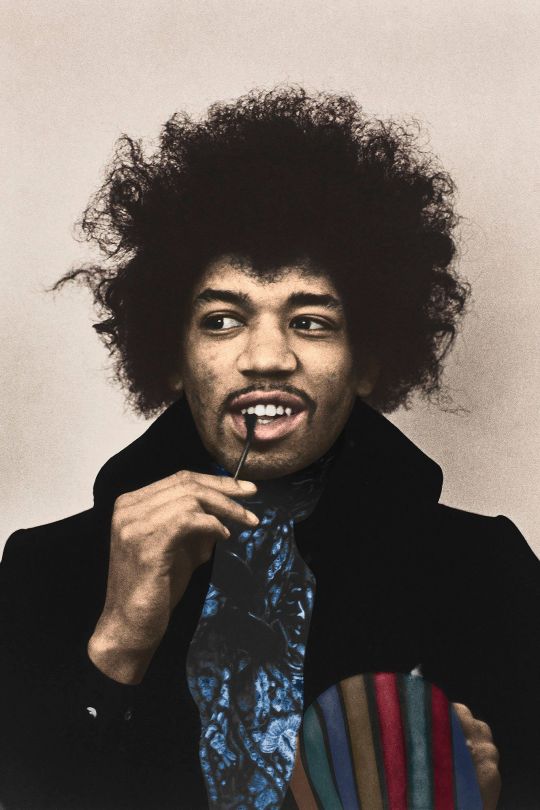
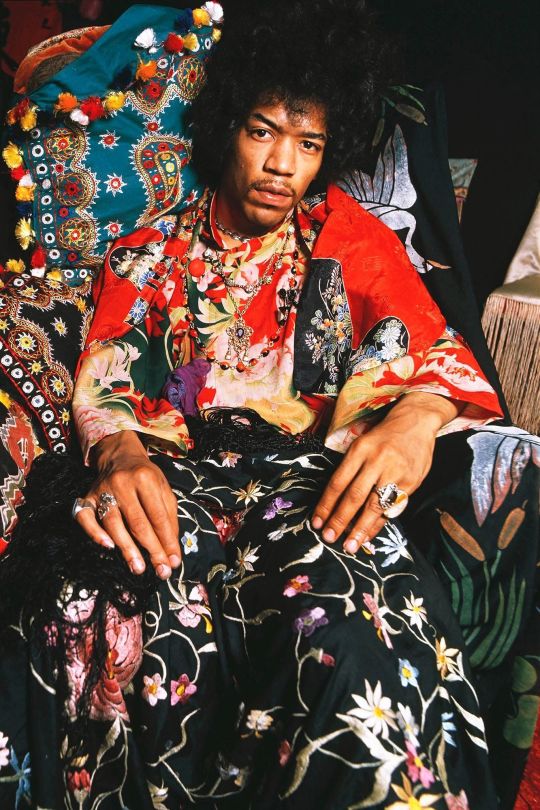
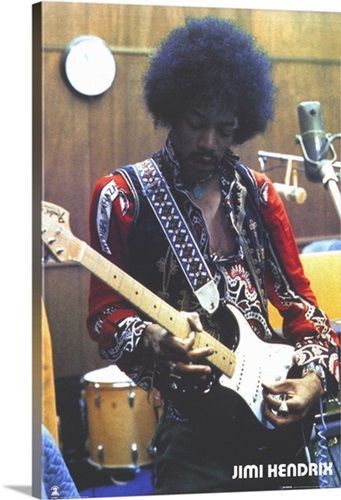


Jimi Hendrix 1942-1970
Jimi had visions and he wanted to create music to express what he saw. He would try to explain this to people, but it didn't make sense because it was not linked to reality in any way.
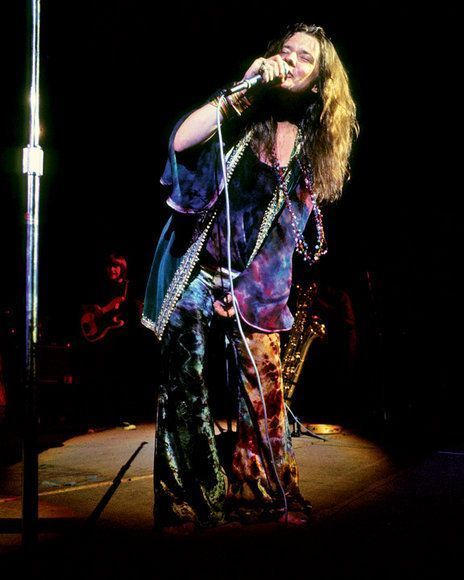
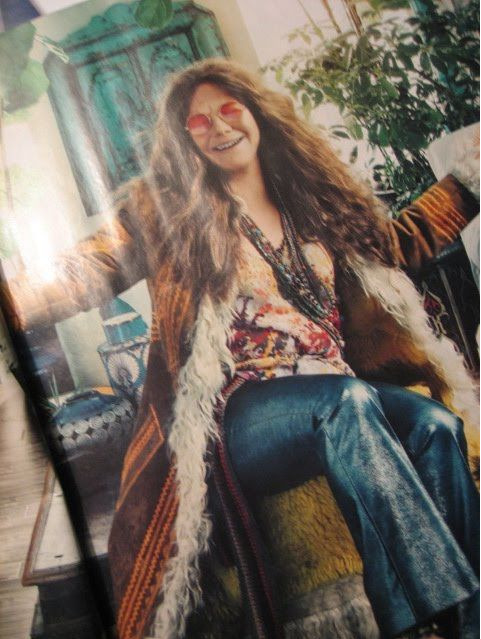


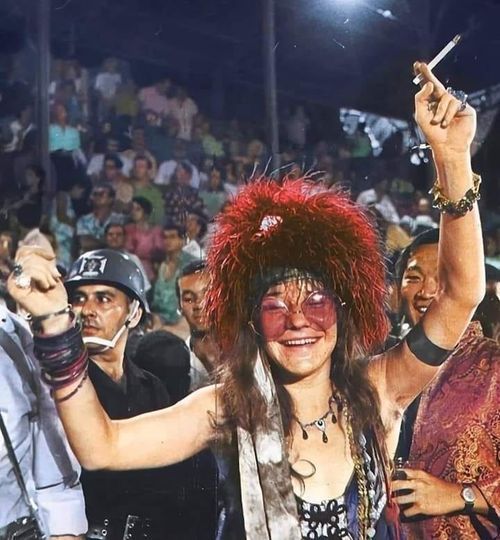
Janis Joplin 1943-1970
She was so inspiring by singing blues music when it wasn't culturally acceptable for white women, and she wore her heart on her sleeve. She was so witty and charming and intelligent.


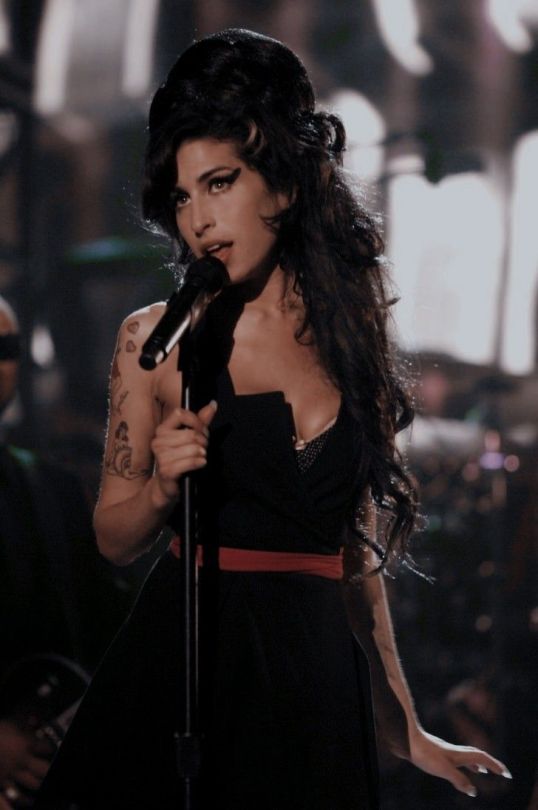
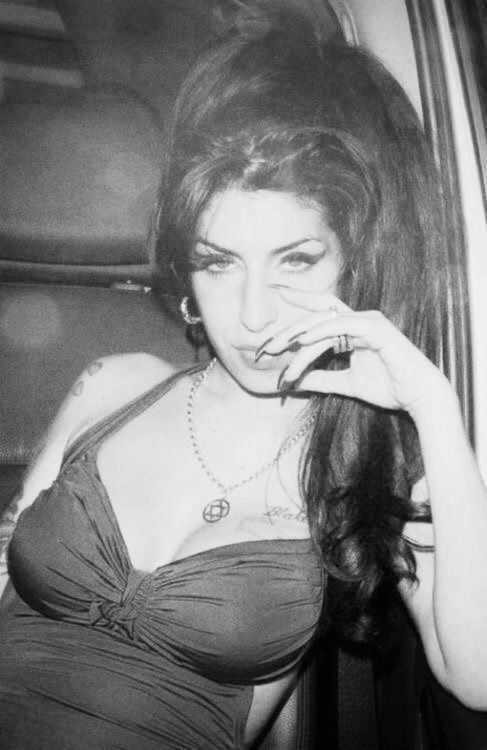

Amy Winehouse 1983-2011
she is very different to what people portray her as being. Yes, she does get out of her mind on drugs sometimes, but she is also a very clever, intelligent, witty, funny person who can hold it together.



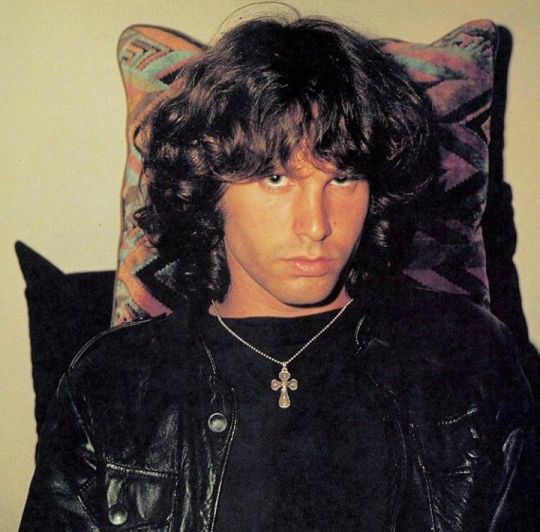
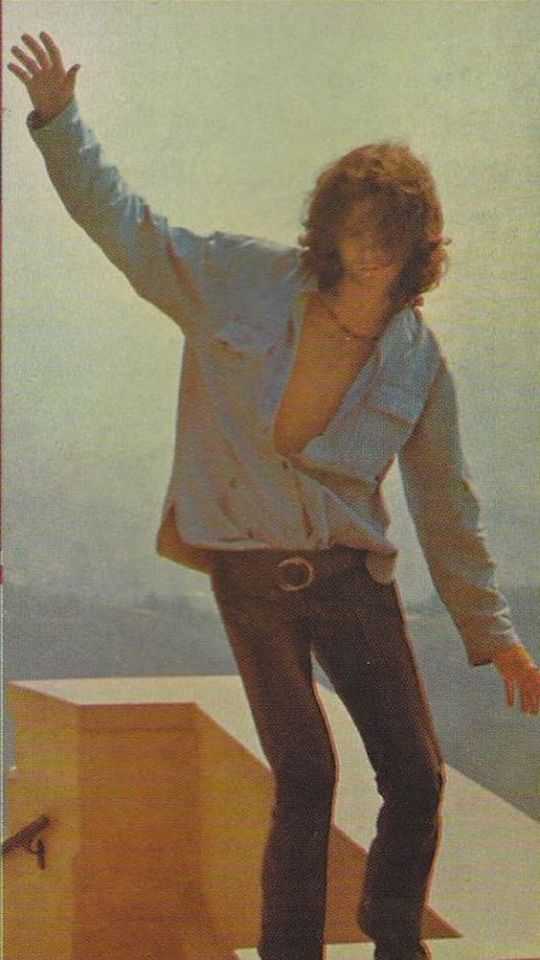
Jim Morrison 1943-1971 (The Doors)
an American rock singer and songwriter. He studied film, where he met the members of what would become The Doors, an iconic band and he would be known for his drinking, drug use and outrageous stage behavior.

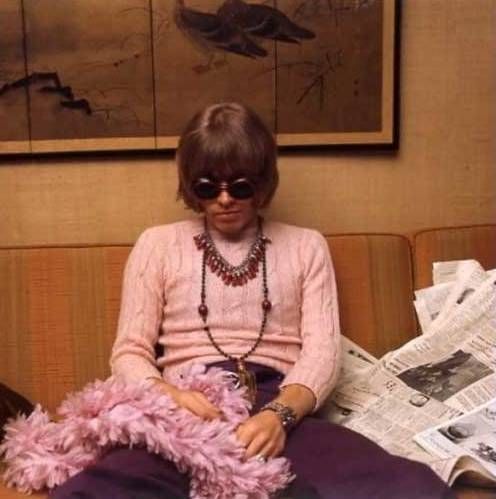



Brian Jones 1942-1969 (The Rolling Stones)
increasingly regal clothes and increasingly long hair, they were called “a bunch of perishing cissies.” Brian, who himself fancied coats with velvet collars, again spoke out. “Intolerant bunch. We’re getting it all the time, but we’ll never change. It’s that lot across there who’re the trouble makers. They’re the ones who lack politeness and they’ve got no excuse. They’re old enough to know better.”
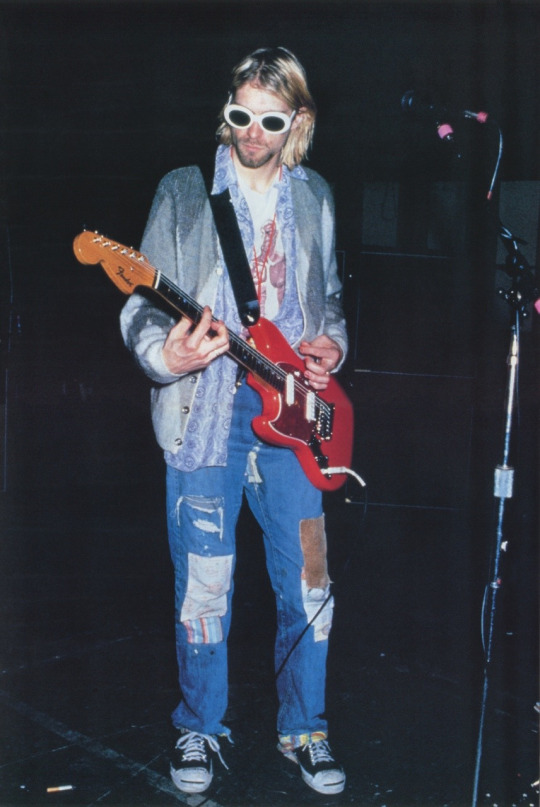
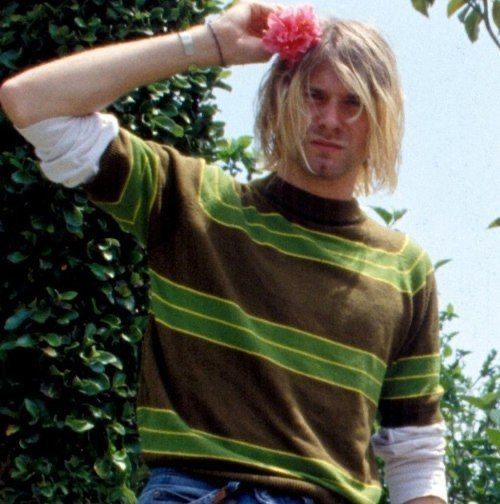



Kurt Cobain 1967-1994 (Nirvana)
Cobain was the kind of person who believed in kindness and treating people justly and with respect. He flitted between narcissism, empathy, love and pain, trying to enjoy his life and simply be himself, but not feeling it, over-feeling everything else instead. the rock legend, was known for turning introverted in social situations. Kurt would sometimes sit alone in a corner for hours without saying a word.
#27 club#90s grunge#kurt cobain#jimi hendrix#janis joplin#jim morrison#amy winehouse#brian jones#the rolling stones#the doors#nirvana#woodstock
134 notes
·
View notes
Note
i just started listening to your choices reading/podcast thing and im a few months late to this so im sure someone else has said this but as a british girl i felt like i had to tell you that we put milk in our tea, not cream. like the idea of cream in tea is very weird to me. we do use sugar though! we also use kettles, not microwaves (i die a little bit inside when i see americans making tea in a microwave). we also use kettles to make coffee (if not a fancy machine) whereas i know americans use coffee makers...? im not 100% what a coffee maker actually is i just know sort of what they look like from films (clear round glass jugs in machine things but also somehow different from cafe coffee machines). this does mean that the couple of times i have been to america i brought a travel kettle with me but almost spilt boiling water all over myself because those things are death traps
i dunno who is making tea in a microwave but that sounds like a criminal offence and they should be arrested
coffeemakers yes
those we do use
BUT MICROWAVE TEA IS NOT A UNIVERSAL NORTH AMERICAN THING i need this to be known
24 notes
·
View notes
Text
I think one of the key differences between American horror and Japanese horror is the use of the uncanny valley.
American horror makers designing ghosts tend to go for what you might consider traditionally scary things, sharp teeth, decaying flesh, glowing eyes, just general monstrosity:
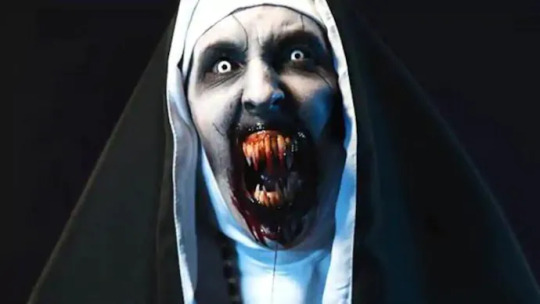

Whereas Japanese movie ghosts tend to look more human:
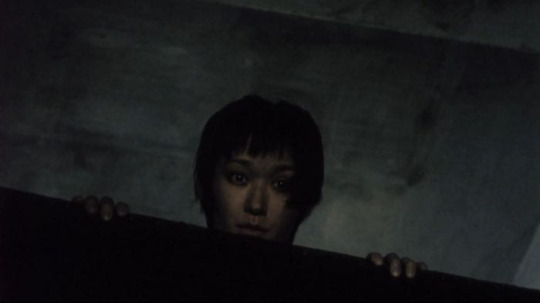
The creepiness factor often comes from their movements. This photo is from Pulse, and this is the most frightening scene due to the way she moves:
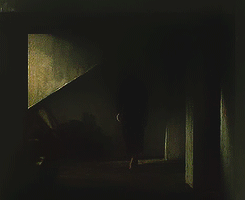
It's odd and unnatural. You might even say it's... uncanny.
A good side-by-side to demonstrate what I mean is with The Ring. Originally a Japanese film, it was remade by Americans a few years later.
Both versions were successful (and good) but I found the Japanese ghost waaaay more frightening than the little CGI creature in the American version. There's just no comparison. I mean, look at the only real shot you get of the ghost's face in each film:
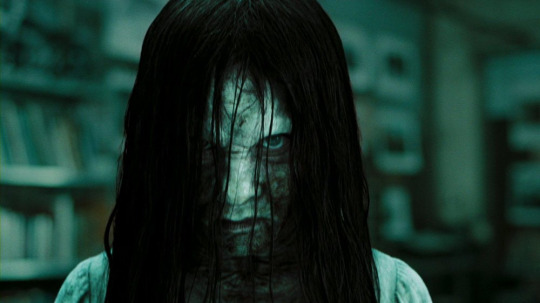

One of these fills me with dread. The other just looks like a zombie.
But here's the real kicker, watch them move!
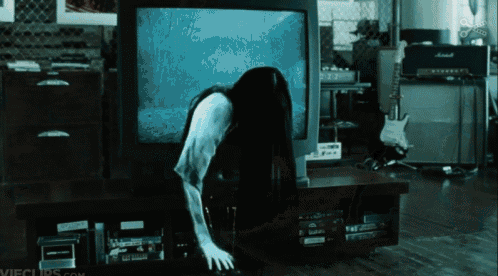
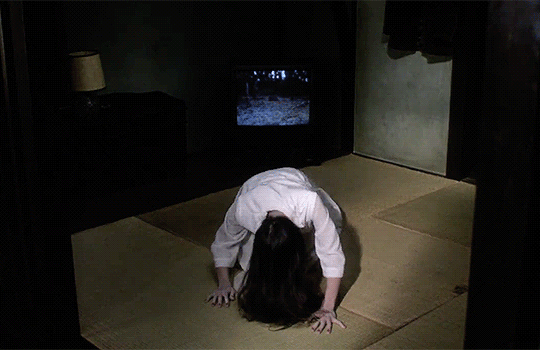
Here's a few differences to note:
The camera in the American version is fast-paced and intense, the Japanese version stays still, letting her and her movements be the focus
It also doesn't cut to her victim nearly as quickly or as often (hard to see from the gif)
The Japanese version is not dirty or oddly colored. The American version puts a digital effect on her. This all pulls the American ghost out of reality, whereas the Japanese version is undeniably a tangible being in the room with us.
This isn't to say American films never use the uncanny valley. Us had a fair bit of odd gestures and stares.


As well as like, everything David Lynch ever made.
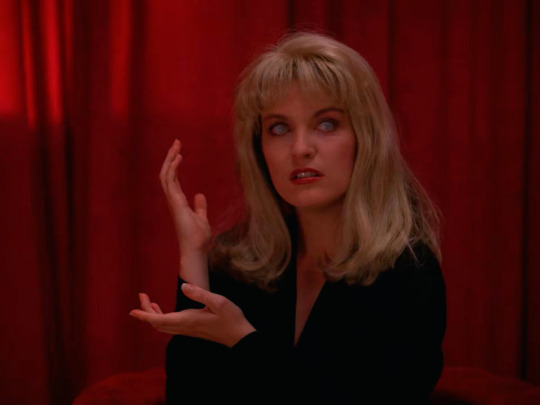
I've also seen these techniques in lower budget short films and analog horror shows on youtube.
But from what I know of Japanese horror (not that much) and American horror (a lot), uncanny valley techniques tend to read to American audiences as "weird" or "surreal" whereas in Japanese horror, it seems to be more of the standard.
American audiences seem to expect a certain type of scariness. The "Conjuring" style of horror if you will. They don't necessarily hate anything outside of that, but they react strongly to it. I mean, everyone said Skinamarink was horrifying, and I'm convinced it because non-horror fans have never been exposed to horror that doesn't have sharp teeth, rotting flesh, and a general aura of ghostliness.
Anyway, I don't know how to end this post except to say that I think Japan was way ahead of the curve on using the uncanny valley in horror and I hope the US catches up because I am quite tired of ghosts with sameface syndrome.
115 notes
·
View notes
Text
Sailor Moon Thought 2! So......Saban Moon

There's a lot to unpack with Toon Makers' version of Sailor Moon back in 1994 or as many fans like to call it, Saban Moon! Before the beloved anime was dubbed by DIC Entertainment in America, people saw the success it was bringing from Japan and wanted a piece of it. The company, Toon Makers had come up with an idea to American-ize the show by starting from scratch and making something both familiar and different to the story of Sailor Moon as a whole! The concept had been to have Sailor Moon and The Sailor Guardians escape to Earth by order of Queen Serenity when Queen Beryl interrupts the union between Sailor Moon and Prince Endymion and launches an attack. Now living on Earth, the girls stay in a female boarding school where they spend their "normal teenage girl" lives until they're summoned again to stop Beryl's evil forces in Space. To make things more interesting, the girls were to be filmed in live action while they were students and then switch to animation once they're called to save the day. Similar to Saban's Power Rangers when they transform from American live action footage to Japanese footage. Hence the nickname, Saban Moon!

The idea was bizarre, strange, and yet....very 90s! While in live action, it seems as though Sailor Moon and The Guardians would have been dealing with the usual adventures of a teenage girl. School dances, sleepovers, boys, makeovers, preparing for exams, and likely discussing plans to stop Beryl. There also seems to be a personality change in our Magical Girls compared to their Japanese counterparts. Sailor Moon is more courageous compared to the crybaby antics she was known for in the first arc. Mercury is more witty and provides comedy rather than being a shy genius. Mars is no longer a shrine maiden, but a more athletic enthusiast by looking at her wardrobe. Jupiter has changed into becoming the friend group's genius by using words such as, "Statistically speaking..." As for Venus, she seems to be the more fashionable and "girly" out of the group. Not only have their personalities changed, but their NAMES as well! Everyone is familiar with the DIC dub names like Serena, Lita, Amy, etc., but not even those were the official names of the girls back then. Usagi was changed to Victoria, Ami was changed to Blue, Makoto was changed to Sara, Rei was changed to Dana, and Minako was changed to Carrie. Only Mamoru's DIC name (Darien) remained.

When the girls aren't hitting the textbooks, they're heading off on their Sky-Flyers to their next Outer Space adventure. I do like the idea of using colorful flying sailboats as it plays on the sailor aspect of Sailor Moon. Very cute and I'm sure it was also meant to sell Sky-Flyer play-sets. It seems as though Queen Beryl is sending her forces out into the galaxy in her search to find The Jewels of Power that our guardians aim to protect. The girls fight their hardest in battle and are even accompanied by the help of Tuxedo Mask (or The Masked Tuxedo) with a single rose to help Sailor Moon use her finishing attack. We also have Sailor Moon's beloved companion, mentor, and talking cat, Luna! However, she's now taken the appearance of a fluffy white cat rather than a skinny black cat. The crescent moon on her forehead is thankfully still present. She takes on the role of alerting the girls whenever trouble arises so they can step into action. The similarities between the original 90s anime and Toon Maker's version aren't too far off from each other. Princess Sailor Moon and daughter of Queen Serenity is sent on a mission to stop the Evil Queen Beryl with the help of The Sailor Guardians, guidance from Luna, and support from Tuxedo Mask. Same concept, but different scenarios and several personality changes.

Unfortunately, Toon Makers was only able to make a one-episode pilot that wasn't picked up for a full series. Filming live action scenes with added animation was too expensive to work with at the time for a Saturday-Morning cartoon. That's when the idea hit that dubbing the anime in English and airing it in America was a cheaper option. While the animation does look messy, there's also this certain charm to it similar to shows like Moon Dreamers, Rainbow Brite, My Little Pony, and She-Ra. The audio may not be the best and the acting can be a little wonky, but it also has that late 80s/early 90s charm sprinkled in. I also appreciate how diverse the cast is when it comes to our leading ladies! Something that I feel would've motivated young lives during the 90s. Had this become a full series that aired on TV, I genuinely believe that I would get into it! This kind of media seemed right up my alley when I was little (and still to this day). I loved MLP, Winx Club, Barbie, Disney Princesses, and I especially gained a love for Sailor Moon! I would've loved to see Toon Makers' spin on the first arc of the anime.....and the other arcs too. Artemis was said to be in the series, so would he have been a black cat instead? What would Chibiusa (or Rini) be like during The Black Moon arc and would she be "Victoria's" future daughter or long-lost little sister since Usagi and Chibiusa gave much more sibling energy in the anime? How would The Outer-Sailor Guardians act during The Death Busters arc? Would they include Helios? Naru (or Molly)? What about Darien? Since Sailor Moon and the girls are staying in a female boarding school, would there have been a rival male boarding school where Darien attends? Could Darien have lost his memories during the attack with Queen Beryl and now takes on a secret identity as Tuxedo Mask? Would Darien and "Victoria" act as school rivals while also pining for each other in their galactic adventures? So much to wonder about....We may not have gotten a series, but we do have the pilot which is now available to see thanks to a special lost media detective, Ray Mona who took so much time and effort to find it. I'll even treat you all to the interesting theme song/music video that came with the pilot! IN THE NAME OF THE MOON, I'LL ENTERTAIN YOU!!!
youtube
#sailor moon#saban moon#Youtube#sailor mercury#sailor jupiter#sailor mars#sailor venus#tuxedo mask#queen beryl#discussion
13 notes
·
View notes
Text

The word “great” is somewhat promiscuously applied to actors. But it was undoubtedly deserved by Sir Michael Gambon, who has died aged 82 after suffering from pneumonia.
He had weight, presence, authority, vocal power and a chameleon-like ability to reinvent himself from one role to another. He was a natural for heavyweight classic roles such as Lear and Othello. But what was truly remarkable was Gambon’s interpretative skill in the work of the best contemporary dramatists, including Harold Pinter, Alan Ayckbourn, David Hare, Caryl Churchill and Simon Gray.
Although he was a fine TV and film actor – and forever identified in the popular imagination with Professor Albus Dumbledore in the Harry Potter franchise – the stage was his natural territory. It is also no accident that, in his private life, Gambon was an expert on, and assiduous collector of, machine tools and firearms for, as Peter Hall once said: “Fate gave him genius but he uses it as a craftsman.”
Off-stage, he was also a larger-than-life figure and a superb raconteur: a kind of green-room Falstaff. I have fond memories of an evening in a Turin restaurant in March 2006 on the eve of Pinter’s acceptance of the European Theatre prize. Gambon kept the table in a constant roar, not least with his oft-told tale of auditioning for Laurence Olivier as a young actor in 1963 and cheekily choosing to do a speech from Richard III; but the next night Gambon gave an explosive rendering of Pinter’s poem American Football that threatened to blow the roof off the Turin theatre.
However, Gambon’s bravura was also mixed with a certain modesty. In the summer of 2008 I met him for tea in London and found him eagerly studying the script of Pinter’s No Man’s Land, in which he was scheduled, several months later, to play Hirst. He told me that he had started work on it so soon because he found it difficult to learn lines at his age.
“Sometimes,” he said, “I sleep with a script under my pillow, or just carry it around in my raincoat pocket, in the hope the lines will rub off on me.” I think he was genuine; but with Gambon, one of life’s great leg-pullers, you were never entirely sure.
Gambon achieved greatness without either the formal training or genetic inheritance that are often considered indispensable.
He was born into a working-class Dublin family that had no artistic background; his mother, Mary (nee Hoare), was a seamstress, and his father, Edward, an engineer. When the family settled in Britain after the second world war, the young Gambon went to St Aloysius school for boys, in Somers Town, central London. On leaving at the age of 15 he signed a five-year apprenticeship with Vickers-Armstrongs, leading to a job as a tool-and-die maker. With his mechanical aptitude, he loved the work. But he also discovered a passion for amateur theatre and, having started by building sets, eventually moved into performing. “I want varoom!” he once said. “I thought, Jesus, this is for me.”
With typical chutzpah, he wrote to the Gate theatre in Dublin, creating a fantasy list of roles that he had played in London, including Marchbanks in Shaw’s Candida; in the end, he made his professional debut there in 1962 as the Second Gentleman in Othello. His best decision, however, on returning to London, was to sign up for an improvisational acting class run by William Gaskill at the Royal Court.
Gaskill was about to join the newly formed National Theatre company at the Old Vic and recommended Gambon for an audition: hence the celebrated story of Gambon’s first encounter with Olivier, which ended with the young actor, in his excess of zeal, banging his hand on a nail in an upstage column and bleeding profusely. Far from being the nail in Gambon’s coffin, this led to a productive four years with the National in which he progressed from walk-ons to substantial roles such as that of Swiss Cheese in Gaskill’s revival of Mother Courage.
On Olivier’s advice, however, Gambon left the National in 1967 to hone and pursue his craft at Birmingham rep – a shrewd move that saw him, at the astonishingly early age of 27, playing his first Othello. He moved on later to the Royal Shakespeare Company, and in 1968 made his first foray into television with the leading role in a BBC adventure series called The Borderers.
However, it was through working on another TV series, The Challengers, that he made a contact that was to transform his career. His fellow actor Eric Thompson was moving into directing, and in 1975 was set to do an Ayckbourn trilogy, The Norman Conquests, at the Greenwich theatre. He cast Gambon, against type, as a dithering vet.
He revealed, for the first time, his shape-shifting gifts; and the sight of him, seated at a dinner table on a preposterously low stool with his head barely visible above the table’s edge, remains one of the great comic images of modern theatre.
This led to a highly productive working relationship with Ayckbourn including key roles in Just Between Ourselves (Queen’s theatre, London, 1977) and Sisterly Feelings (National, 1980).
At the same time, Gambon began an association with Gray by taking over, from Alan Bates, the role of the emotionally detached hero in Otherwise Engaged (Queen’s theatre, 1976).
That was directed by Pinter, for whom in 1978 Gambon created the part of Jerry in Betrayal at the National. It was a production beset by problems, including a strike that threatened to kibosh the first night, but Gambon’s mixture of physical power and emotional delicacy marked him out as a natural Pinter actor. That power, however, manifested itself in the 1980s in a series of performances that staked out Gambon’s claim to greatness.
First, in 1980, came Brecht’s Galileo at the National: a superbly triumphant performance that brought out the toughness, obduracy and ravening intellectual curiosity of Brecht’s hero. It was a measure of his breakthrough that, as Gambon returned to his dressing room after the first night, he found the other actors in the National’s internal courtyard were shouting and roaring their approval. Two years later, Gambon returned to the RSC to play both a monumental King Lear and a ravaged Antony opposite Helen Mirren’s Cleopatra.
But arguably the finest of all of Gambon’s 80s performances was his Eddie Carbone in Arthur Miller’s A View from the Bridge, directed by Ayckbourn at the National (1987). It helped that Gambon actually looked like Miller’s longshoreman-hero: big and barrel-chested with muscular forearms, he was plausibly a man who could work the Brooklyn docks.
Gambon also charted Eddie’s complex inner life through precise physical actions. He stabbed a table angrily with a fork on learning that his niece had got a job, let his eyes roam restlessly over a paper as the niece and the immigrant Rodolpho quietly spooned, and buckled visibly at the knees on realising that a fatal phone-call to the authorities had ensnared two other immigrants. In its power and melancholy, this towering performance justified the sobriquet once applied by Ralph Richardson of “the great Gambon”.
When you consider that the decade also saw Gambon playing the psoriasis-ravaged hero of Dennis Potter’s TV series The Singing Detective (1986), you realise his virtuosity and range.
And that became even clearer in 1990 when he played the mild-mannered hero of Ayckbourn’s Man of the Moment (Globe theatre, now Gielgud, London), had another crack at Othello for Ayckbourn in Scarborough and appeared, in 1989, as a romantically fixated espionage agent in Pinter’s TV adaptation of Elizabeth Bowen’s The Heat of the Day: that last performance, alternately sinister and shy, was one of Gambon’s finest for television and deserved a far wider showing.
In later years Gambon successfully balanced his stage career with an amazingly prolific one in film and television. In Hare’s Skylight at the National in 1995 he combined the bulk and weight of a prosperous restaurateur with a feathery lightness – a skipping post-coital dance across the stage with the balletic grace often possessed by heavily built men.
Gambon was equally brilliant as a disgusting, Dickensian, accent-shifting Davies in a revival of Pinter’s The Caretaker (Comedy theatre, 2000), as a perplexed bull of a father in Churchill’s A Number (Royal Court, 2002), as a Lear-like Hamm in Beckett’s Endgame (Albery, 2004) and as a brooding, alcoholic Hirst in Pinter’s No Man’s Land (Duke of York’s, 2008). Even if Gambon’s Falstaff in a 2005 National Theatre production of Henry IV Parts One and Two did not quite match expectations, his work for the theatre revealed an ability to combine volcanic power with psychological depth and physical delicacy.
Ill health and increasing memory problems forced him to retire from stage acting in 2015, but not before he had given memorable performances in two Beckett plays: Krapp’s Last Tape (Duchess, 2010) and All That Fall (Jermyn Street theatre, 2012), where he played, opposite Eileen Atkins, the sightless but stentorian Mr Rooney.
He also continued to work in television and film for as long as possible. He belied the whole notion of the small screen by giving large-scale performances as the black sheep of a big family in Stephen Poliakoff’s Perfect Strangers (2001) and as a reclusive plutocrat in the same writer’s Joe’s Palace (2007).
He was nominated for awards for his performances as Lyndon Johnson in an American TV movie, Path to War (2002), and as Mr Woodhouse in a BBC version of Jane Austen’s Emma (2009). Later TV series included The Casual Vacancy (2015), Fearless (2017) and Little Women (2017).
In film, he had a rich and varied career that ranged from the violent hero of Peter Greenaway’s The Cook, the Thief, His Wife and Her Lover (1989), to a heavyweight mafia boss in Mobsters (1991), the aged Lord Marchmain in Brideshead Revisited (2008), a cantankerous old director in Dustin Hoffman’s Quartet (2012) and the bearded Hogwarts headteacher (whom he privately referred to as “Dumblebore”) in six of the eight Harry Potter films, taking over the role for Harry Potter and the Prisoner of Azkaban (2004) following the death of Richard Harris.
He also provided the narration for the Coen brothers’ Hail, Caesar! (2016) and voiceovers for the two Paddington films (2014 and 2017).
But Gambon brought to everything he did, in life as well as art, enormous gusto, a sense of mischief and a concern with precision: he was almost as happy restoring old firearms as he was working on a new role.
In 1992 he was appointed CBE, and six years later was knighted.
He married Anne Miller in 1962, and they had a son, Fergus. From a subsequent relationship with Philippa Hart, whom he met on the set of Gosford Park, he had two sons, Michael and William.
He is survived by Anne and his three sons.
🔔 Michael Gambon, actor, born 19 October 1940; died 27 September 2023
Daily inspiration. Discover more photos at Just for Books…?
52 notes
·
View notes